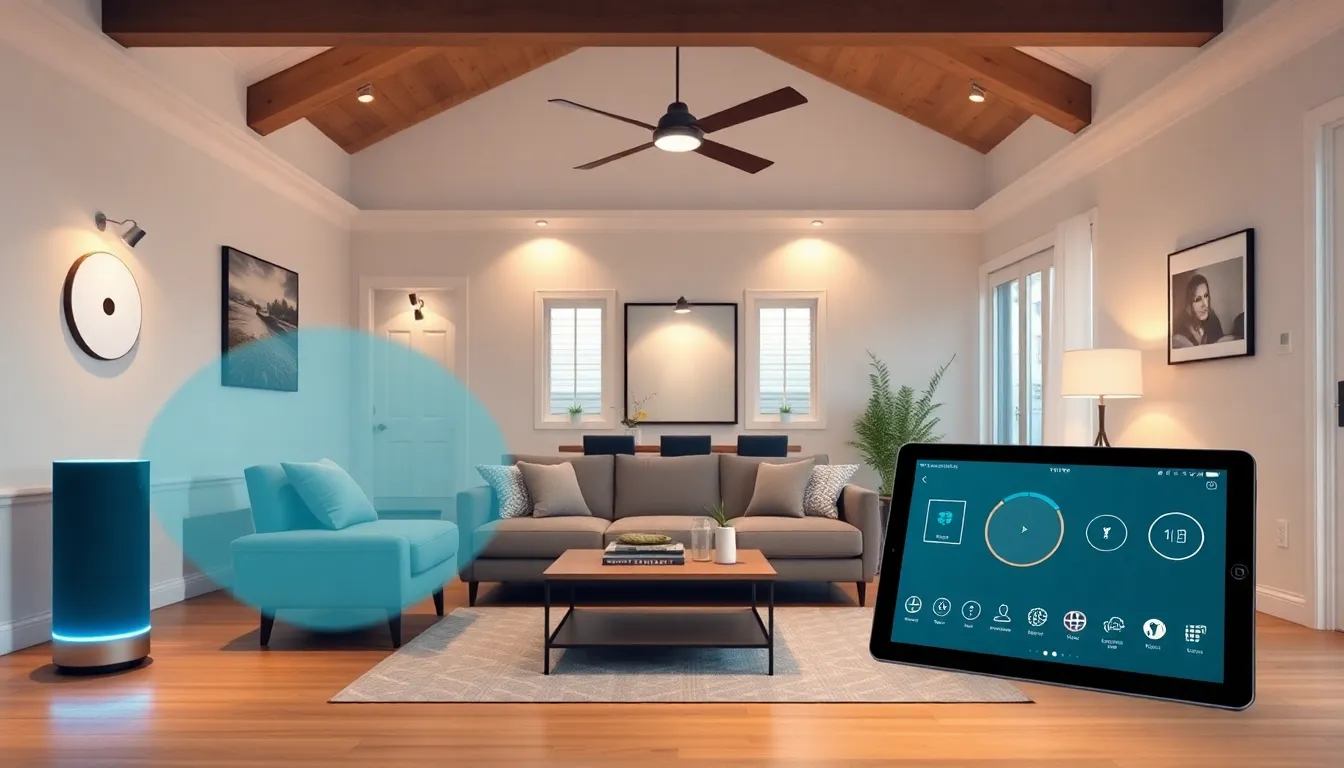Imagine walking into your home and having the lights flick on as if they’ve been waiting for you like an eager puppy. Home automation installation isn’t just a trend; it’s the secret sauce that transforms ordinary living spaces into smart havens. With a few clever gadgets and a sprinkle of tech magic, everyday tasks can become seamless and even a little fun.
Table of Contents
ToggleOverview Of Home Automation Installation
Home automation installation integrates various smart devices to streamline daily tasks in a living environment. It centralizes control over equipment such as lighting, heating, and security systems into a single interface. This integration allows for greater energy efficiency and improved convenience.
Smart lighting systems adjust automatically based on occupancy or schedule. Gamers or movie enthusiasts appreciate how smart entertainment systems create immersive experiences. Security cameras and smart locks enhance safety by providing real-time monitoring and remote access.
Temperature control devices offer customizable settings, maintaining comfort while saving energy. Homeowners can manage everything through smartphones or voice-activated assistants. Many devices feature compatibility with home networks, allowing seamless interaction between different brands.
Installing smart home systems often involves assessing the existing infrastructure. Identifying the right technology can maximize the benefits of automation. Professionals typically suggest a phased approach, starting with essential components like lighting or thermostats. Electrical requirements may necessitate professional installation, ensuring safety and efficiency.
Cost varies depending on device selection and installation complexity. Budgets can accommodate both basic setups and comprehensive systems. Planning carefully helps to align needs with available technology and functionality.
Overall, home automation installation presents an exciting opportunity to enhance everyday living. It offers convenience, efficiency, and security through thoughtful integration of modern technology.
Benefits Of Home Automation

Home automation offers various advantages that significantly improve daily life. Enhanced synergy between smart devices creates a seamless living experience.
Increased Convenience
Convenience stands out as a primary benefit of home automation. Smart devices manage routine tasks, allowing homeowners to control lighting, heating, and appliances from a single interface. Voice commands simplify operations further, eliminating the need for manual adjustments. Automated lighting adjusts according to schedules or occupancy, promoting efficient energy use. Additionally, smart entertainment systems deliver personalized experiences tailored to individual preferences. With customizable settings, users easily adapt their home environment to match their lifestyle. Overall, these technologies save time and effort, making daily activities more enjoyable.
Enhanced Security
Home automation significantly boosts security levels. Smart locks provide keyless entry, allowing homeowners to grant access remotely. Security cameras deliver real-time video feeds, ensuring constant monitoring of property. Automated alerts notify homeowners of unusual activities, enhancing awareness. Integration with alarm systems allows for instant activation when needed. Remote access features enable users to check on their homes from anywhere, increasing peace of mind. Furthermore, smart motion sensors detect movement and activate security lights, adding another layer of protection. Overall, these elements create a safer home environment, contributing to increased comfort and confidence.
Types Of Home Automation Systems
Home automation systems enhance lifestyle convenience and efficiency. Various categories exist to cater to different needs.
Smart Lighting
Smart lighting systems adapt to occupancy and time schedules. These systems utilize sensors to turn on or off based on presence, ensuring energy efficiency. Homeowners can control lighting via mobile apps or voice commands. Customizable options include brightness and color, allowing for mood setting or security lighting. Compatibility with other smart home devices enables seamless integration. This flexibility enhances both ambiance and safety within the home.
Climate Control Systems
Climate control systems maintain consistent temperatures throughout the home. Programmable thermostats adjust settings based on user preferences or daily routines. This technology saves energy by reducing heating or cooling during unoccupied periods. Remote access through smartphones empowers homeowners to modify settings while away. Systems may include smart vents, thermostats, and integrated HVAC systems. Overall, these solutions contribute to a comfortable living environment while promoting energy efficiency.
Preparing For Installation
Preparing for home automation installation involves careful planning and consideration. Assessing needs and selecting devices are crucial steps to achieve optimal results.
Assessing Your Needs
Identify key areas for automation within the home. Consider whether enhancing security, improving energy efficiency, or boosting convenience takes priority. Evaluate the existing infrastructure to determine compatibility with smart devices. Reviews and user experiences provide valuable insights into the most effective systems. Gather input from all household members to understand their preferences and requirements. Create a concise list of must-have features and desired functionalities. This structured approach ensures that the final system meets the needs of everyone involved.
Choosing The Right Devices
Explore various smart devices available in the market. Options include smart lights, thermostats, security cameras, and voice assistants, each contributing uniquely to home automation. Analyze compatibility with existing systems before making a decision. Manufacturers often offer comprehensive packages, simplifying the selection process. Price ranges vary, so set a budget that aligns with desired functionalities. Read product reviews to gauge performance and reliability. Prioritize devices that integrate seamlessly with a central hub for easier management. Each decision shapes the overall efficiency and effectiveness of the home automation experience.
Installation Process
The installation process determines the efficiency and functionality of any home automation system. Homeowners often face two main options: DIY installation or professional assistance.
DIY Installation
DIY installation offers flexibility for those comfortable with technology. Homeowners can follow step-by-step guides provided by device manufacturers, allowing for a personalized setup. Start with assessing one’s existing infrastructure to ensure compatibility with new devices. Prioritize simpler systems, such as smart lighting or plugs, to gain confidence before tackling more complex installations. Resources online, like video tutorials, make this option accessible. Many devices come with user-friendly apps, simplifying control right from the start. Challenges may arise, but troubleshooting tips are often available in forums or customer support.
Professional Installation
Professional installation provides expertise that ensures optimal performance and safety. Technicians assess the home’s layout and recommend systems tailored to specific needs, offering insights on the best devices to use. They handle all wiring and configuration tasks, minimizing the risk of errors during setup. Homeowners save time by letting professionals manage the intricacies of device integration. Costs can vary depending on the complexity of the system and the labor required. Seeking multiple quotes allows for comparisons on pricing, providing options within various budgets. Ultimately, choosing professional help leads to a seamless, reliable home automation experience.
Common Challenges And Solutions
Home automation installation presents several challenges that homeowners encounter. Technical issues frequently arise, such as connectivity problems between devices. Understanding the network requirements of smart devices can mitigate these issues.
Another common challenge involves device compatibility. Ensuring all devices work harmoniously with a central hub simplifies overall management. Researching compatibility specifications before purchasing helps avoid this frustration.
Installation complexity also presents difficulties. Homeowners may find troubleshooting errors daunting. Accessing online forums or user manuals often provides quick solutions. Seeking professional assistance remains a viable option for those preferring expert intervention.
Cost concerns also weigh heavily on decisions. Device prices can vary significantly, impacting total installation expenses. Setting a budget beforehand allows for smart selections while maximizing value.
Maintenance needs often become an overlooked aspect. Regular updates are essential for security and functionality. Scheduling routine checks on devices ensures ongoing performance and helps detect issues early.
User education stands out as another critical factor. Homeowners might not fully utilize the capabilities of their smart systems. Taking time to explore apps and features contributes to a more enriching experience.
Privacy and security issues present real concerns as well. Integrating devices increases vulnerability to cyber threats. Configuring strong passwords and enabling two-factor authentication significantly enhances security.
Lastly, time management can pose a challenge during the installation process. Balancing work and family obligations with the demands of setup may feel overwhelming. Organizing a timeline that allocates specific days for installation tasks reduces stress and ensures a smoother experience.
Home automation installation offers a transformative experience for homeowners seeking convenience and efficiency. By integrating smart devices, individuals can streamline daily tasks and enhance their living environments. The ability to control lighting, climate, and security from a single interface not only simplifies life but also promotes energy savings.
As technology continues to advance, the opportunities for customization and integration will only expand. Homeowners are encouraged to carefully plan their installations and consider their unique needs. Whether opting for DIY or professional assistance, a well-thought-out approach ensures a successful transition to a smarter home. Embracing home automation can lead to a more enjoyable and secure living experience.


